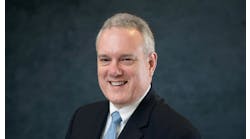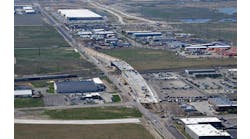By Suze Parker, Contributing Author
Central Florida is one of the nation’s fastest growing regions. From 2017 to 2018, Orlando’s population increased by more than 60,000 people. In that one-year stretch, Tampa grew by more than 50,000 people.
The Florida Department of Transportation (FDOT) began planning the buildout of Interstate-4, the region’s main thoroughfare and busiest highway, in the 1980s. A public-private partnership concession agreement, signed in 2014, kicked off the project in earnest.
And the population growth over the past few years has proved how badly the region needs an “ultimate” infrastructure project.
The I-4 Ultimate project is FDOT’s largest infrastructure project, and it will transform transportation, ushering in an era of mobility, safety, and access in central Florida.
FDOT chose HNTB to provide construction oversight, a role that included managing the public-private partnership agreement throughout the construction period. Supported by more than a dozen local, state, and federal agency representatives, FDOT broke ground on the massive, $2.3 billion I-4 Ultimate project in 2015.
The project aimed to remake every inch of pavement on the 21-mile corridor, widening it and adding capacity and congestion relief with four new express lanes – two in each direction – within the center right-of-way.
“I-4 at the time largely was comprised of the original interchanges and horizontal and vertical alignments from when it was first constructed,” said John Tyler, FDOT District 5 secretary. “The infrastructure needed to be rebuilt to current standards to handle the region’s present and future traffic growth. FDOT was committed to improving safety and mobility on this vital highway.”
Originally, the I-4 Ultimate project was envisioned as a series of smaller jobs that would have been conventionally funded through transportation taxes and legislative processes – an approach that could have stretched construction up to 27 years.
“To deliver the project in about seven-and-a-half years, as FDOT has done, was a monumental achievement by the agency and the [public-private partnership] team,” said Mike Gwynne, HNTB construction oversight services resident engineer. “The project stakeholders, which include several water-management districts and nine agencies, city and county jurisdictions across the 21 miles, began partnering with FDOT 20 years before a shovel was put in the ground, and continued working collaboratively with the FDOT and [partnership] team throughout construction.”
Once an agreement was reached on interchange alignments, aesthetic concepts and the right-of-way, the cities entrusted FDOT with their streets and helped manage the impacts of construction to their communities to deliver this program, according to Gwynne.
Tragedy Creates Opportunity
Most of I-4 Ultimate’s lane miles lie within Orlando city limits. The interstate runs through the heart of downtown, where work on the important I-4/State Road 408 interchange began shortly after project construction commenced.
Throughout the project area, numerous major crossroads intersect the interstate. Of the 15 major interchanges completely reconstructed as part of the project, I-4/S.R. 408 was the most complex.
Orlando has grown around I-4 since the roadway was constructed in the 1950s and 1960s. Amway Center, home to the NBA’s Orlando Magic, stands at one corner of the I-4/S.R. 408 interchange; City Hall stands at another.
On the other two sides, residential communities were built up to the right-of-way limits. Utility lines are pervasive, and an Orlando Utilities Commission substation that supplies downtown power is located within the envelope of the new interchange.
These constraints left the project team little space to maneuver. New ramps from surface streets onto S.R. 408 were built several stories higher than the previous ramps had been. Travel lanes, too, had to be constructed at higher elevations over the existing lanes while simultaneously building capacity outward horizontally.
To streamline traffic for the 200,000 drivers who navigate through downtown Orlando each day, travel lanes and bridge and ramp movements remained open during peak travel times, with closures limited mostly to overnight hours.
A complicated set of temporary bridges over Church and South Streets was constructed to keep interstate traffic moving while the construction team removed the old eastbound I-4 lanes and built new ones.
When COVID-19 struck in early 2020 and forced a shutdown, FDOT accelerated key projects, including the I-4/S.R. 408 downtown interchange.
“I-4 Ultimate was viewed as an economic driver to help the state recover from the effects of COVID-19,” Gwynne said.
Accelerating the project did not create congestion in downtown Orlando because traffic volumes that were down 30% or more.
“Among the steps the contractor took were more lane and ramp closures for longer periods during the daytime hours,” Tyler said. “To finish work on the I-4/S.R. 408 interchange, the contractor took the westbound I-4 mainline to a single lane for a week — an action that wouldn’t have been possible without the dramatic reduction in traffic congestion during the pandemic.”
The I-4/S.R. 408 interchange opened to traffic in summer 2020 — six months ahead of schedule because of the COVID-related project acceleration — as a four-level interchange with sweeping flyover ramps as high as 120 feet above the ground.
Conceived in cooperation with S.R. 408’s owner, Central Florida Expressway Authority, and considered the crown jewel of the I-4 Ultimate project, the interchange modernized connections between central Florida’s two busiest highways, reducing travel times and transforming Orlando’s skyline.
Construction Oversight
The I-4 Ultimate concession agreement delivery model allowed for the concessionaire team, which included a design-build contractor and a sampling, testing, and inspection consultant, to inspect and accept its own work.
Since the project was partially funded with federal dollars, FDOT and the Federal Highway Administration (FHWA) entered into a project-specific agreement that enabled the delivery model to proceed, with the stipulation that FDOT, as the state highway agency and project owner, would have construction oversight services to ensure that concessionaire quality acceptance processes complied with the contract documents.
HNTB administered the exceptionally complex public-private partnership agreement. Besides monitoring construction quality, stringent performance measures in the contract called for auditing the day-to-day operations of the concessionaire, its contractors, and its consultants.
These audits made sure contractual standards for traffic flow, accident clearing, hurricane response and other operational requirements were met.
To carry out this unique assignment efficiently and with as little disruption to the concessionaire team as possible, HNTB developed a cutting-edge, risk-based audit program and software tool (RBAP) in cooperation with FDOT.
RBAP’s requirements verification database — a collection of requirements extracted from the agreement – form individual, auditable ‘data points’ that can be updated in minutes.
Beyond contract oversight and helping the concessionaire develop solutions, HNTB coordinated construction activities, including lane closures and detours, with the nine jurisdictions across the project length. HNTB also worked closely with FDOT’s public information consultant to distill information and engineering drawings into concepts the public could easily absorb.
“HNTB’s team brought FDOT and the state some of the best bridge and roadway inspectors, engineers and schedule expertise available on the market,” Tyler said.
The I-4 Ultimate project’s benefits extend far beyond the signature corridor itself. Motorists now experience an I-4 with greatly improved safety, connectivity, and mobility, with some peak-hour travel times reduced up to 20 minutes. RB



